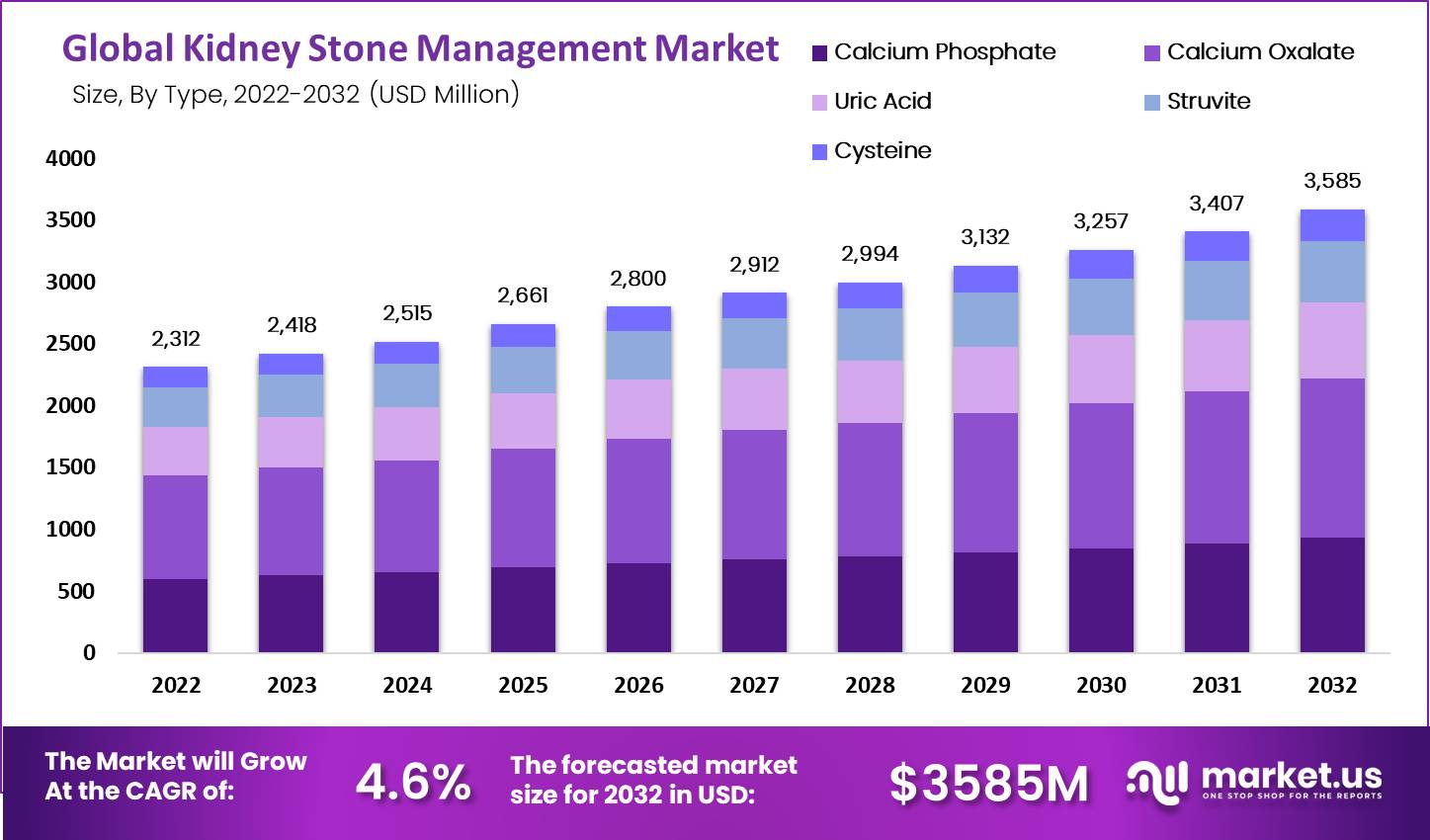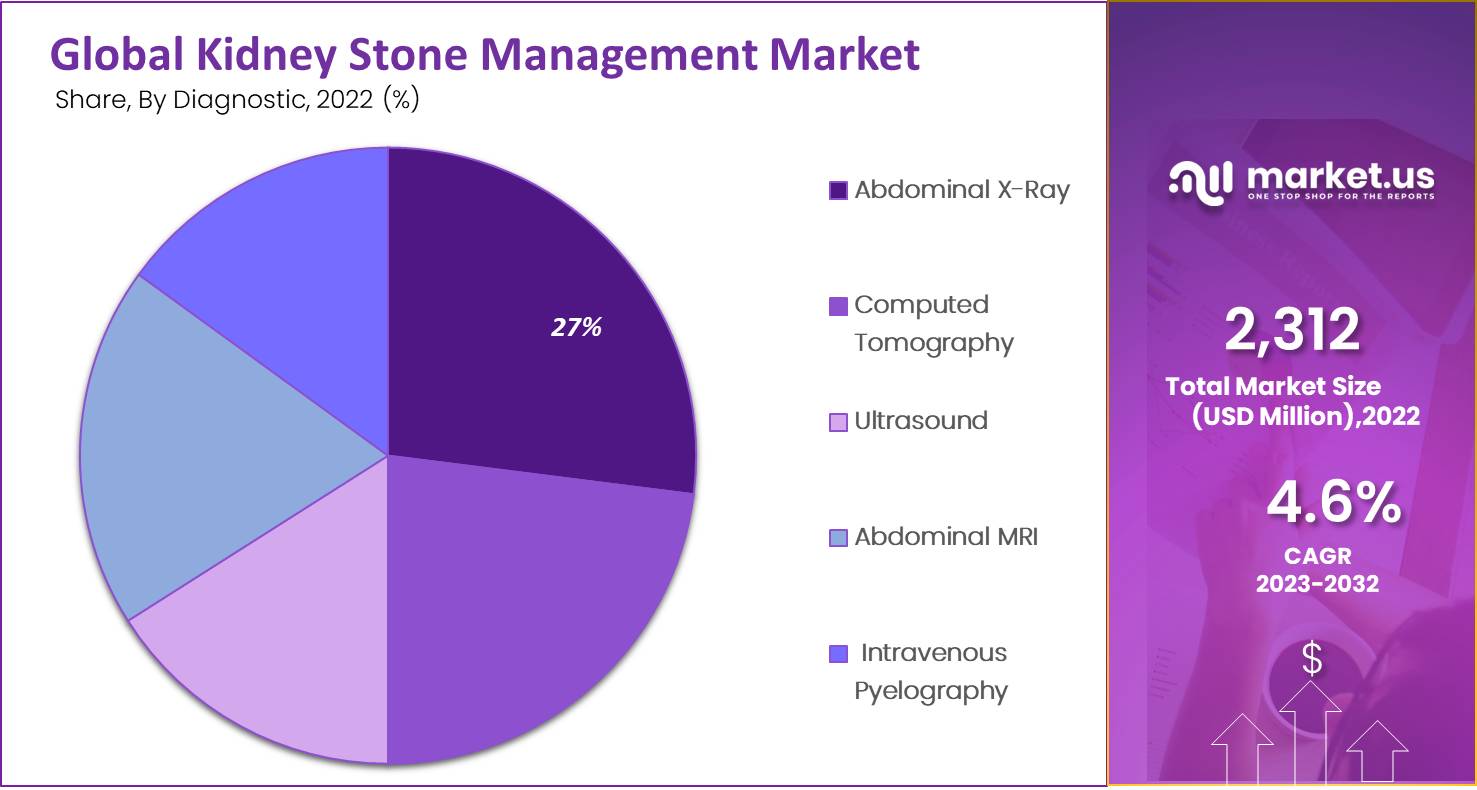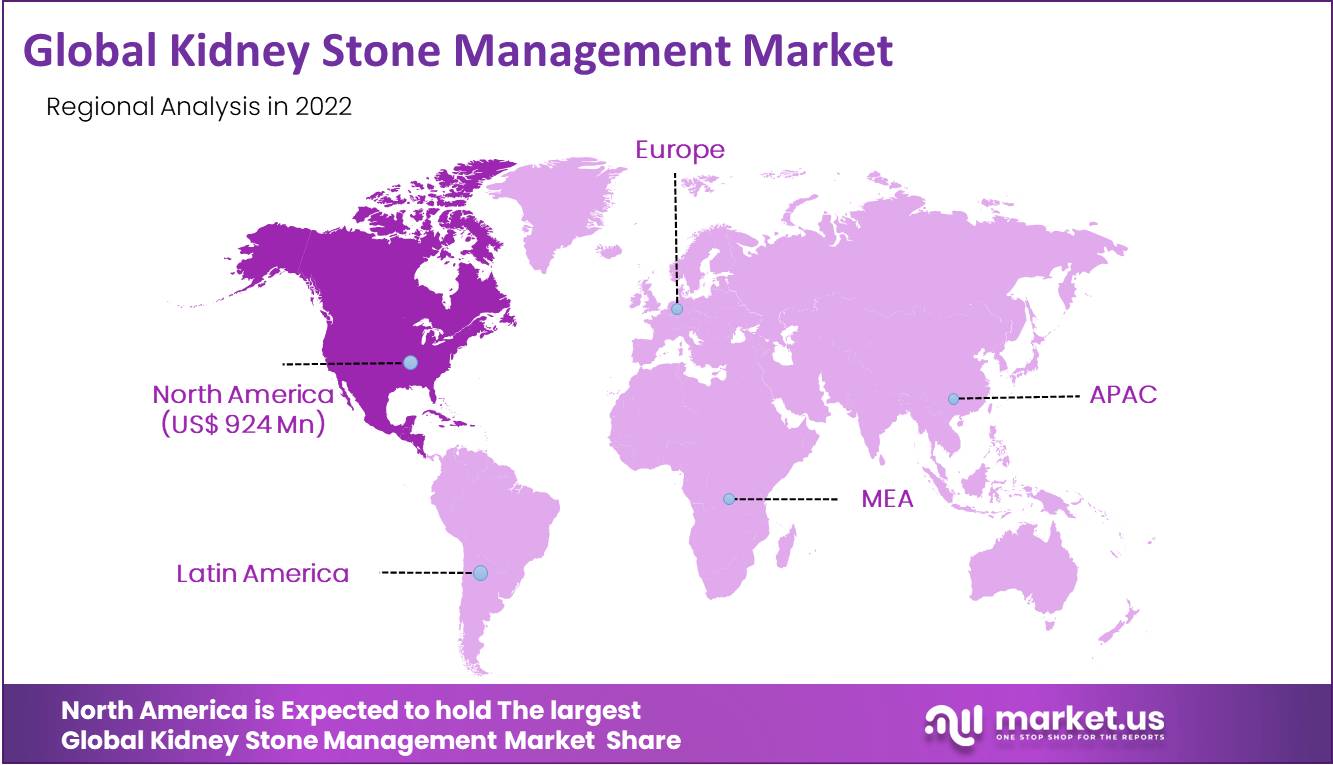Global Kidney Stone Management Market by Type (Calcium Phosphate, Calcium Oxalate), By Treatment (Extracorporeal Shock Wave Lithotripsy, Ureteroscopy and Percutaneous Nephrolithotomy), By Diagnostic (Abdominal X-Ray, Computed Tomography, Ultrasound,), By End User (Hospitals, Specialty Clinics), By Region and Companies - Industry Segment Outlook, Market Assessment, Competition Scenario, Trends, and Forecast 2023-2032
- Published date: Oct 2023
- Report ID: 95375
- Number of Pages: 274
- Format:
- keyboard_arrow_up
Quick Navigation
Report Overview
Global Kidney Stone Management Market size is expected to be worth around USD 3,595 Million by 2032 from USD 2,312 Million in 2022, growing at a CAGR of 4.63% during the forecast period from 2022 to 2032.
Kidney stones are hard deposits made up of minerals and salts that come from inside human kidneys. This disease is a crystal concretion formed usually within the kidneys. It has been connected with a rise in the risk of end-stage renal failure. Kidney stone does not cause permanent damage if recognized earlier and treated appropriately. Based on the size of the stone, treatment may include drinking much water and allowing the stone to pass naturally.
Moreover, the increase in the prevalence of kidney stones is further dividing the market. The primary cause of such deposits includes using certain medications and supplements due to specific conditions and excess body weight. When the Urine becomes sometimes concentrated, the waste products crystallize inside the kidney. After some time, these crystals may build as a hard lumpy deposit. The mineral constituent of kidney stones is calcium oxalate, calcium phosphate, and calcium carbonate.
Most stones are formed due to a combination of genetics and environmental factors. A small stone may cause the symptom. If stones grow to a sufficient size, they can obstruct the ureter; kidney pain is often known as renal colic pain and commonly comes in waves lasting 20-60 minutes. Blockage of the ureter can cause decreased function and dilation of the kidney. The consequences of kidney stones which comprise bleeding around the kidneys, block of Urine due to broken stones, and high arterial blood pressure. However, the advantages related to the early detection of kidney stones and their treatment will lead to higher demand for nephrolithiasis.

*Actual Numbers Might Vary In The Final Report
Key Takeaways
- The global kidney stone management market is projected to reach USD 3,595 Million by 2032 and grow at a compound annual compound growth rate of 4.63% during its forecast period.
- A growing prevalence of kidney stones, an increasing demand for minimally invasive procedures and the rise in adoption of innovative technologies are driving market expansion.
- North America represents the leading market for kidney stone management, followed by Europe and Asia-Pacific.
- Ureteroscopy is projected to remain the market leader over the forecast period.
- Hospitals are projected to account for the largest market share during this forecast period.
Type Analysis
The market for kidney stone management is segmented based on type: calcium phosphate, calcium oxalate, uric acid, struvite, and cysteine. Among types, calcium oxalate is expected to hold a significant revenue share in the target market. The calcium oxalate segment is expected to grow at a CAGR of 4.5%. Calcium oxalate is usually the most developing kidney stone in the body due to the high level of oxalate in the Urine and less water intake. These stones may stick together and form a solid mass. Kidney stones are solid masses in the kidney due to increased oxalate levels. Oxalates are the type of substance that form crystals in the Urine.
This is due to too much oxalate to calcium during Urine being made in the kidneys. Also, various risk factors comprise diet intake, including high levels of protein oxalate, sugar, and sodium, which may form calcium oxalate crystals. Calcium oxalate stones are formed when the Urine has low pH. Struvite stones are found predominately in women with urinary tract infections. Cysteine stones are one of the rare types of kidney stones. Calcium phosphate stones are the less common type of kidney stones.
The kidney stone market can also be separated based on treatment type lithotripsy, ureteroscopy, and percutaneous nephrolithotomy. The ureteroscopy section will carry the most significant market growth share during the forecast period. This is because it treats those invisible stones on x-ray machines, which has been increasing in popularity among several healthcare organizations. In addition, standard procedure costs and increased utilization of shockwave lithotripsy procedures contribute to the segment growth. Extracorporeal shock wave lithotripsy is also a type of treatment used to cure kidney stones.
Based on Diagnosis Analysis
Based on the diagnosis, the market is segmented into various advanced technologies such as CT scans, X-rays, and ultrasound rays, which will likely drive the market in the near future. Among these, the computed tomography segment in the kidney stone management market is anticipated to reach millions. Computed tomography is a generally used imaging method. For stone diagnosis, as it authorizes three-dimensional views of stone. T
he technology obtains multiple numbers of data points with the benefit of a radiation source rotating through the patients forming three-dimensional images. These complete images result from using CT scanners authorized by healthcare professionals to determine the proper treatment for the patient, thereby contributing to better healthcare outcomes thus driving the segment growth. CT Scan also provides additional information regarding the types of stones that facilitate better treatment plans, growing the product approval for kidney stone management, thus augmenting the industry demand.

End-User Analysis
Based on end-user, the market is sectioned into hospitals, specialty clinics, and ambulatory surgical centers. Among these end-users, the hospital segment held the majority of the market share in the kidney stone management market. Increasing number of patients with kidney stones and the adoption of advanced technologies by hospitals are dividing the part. The hospitals and clinics segment held the largest revenue share over the forecast period and is expected to maintain its position during the forecast period.
The necessary instruments required for kidney stone elimination treatment are readily available in hospitals compared to ambulatory services and specialty clinics. The patient surgery centers are healthcare facilities where surgical methods that do not need hospitalization are carried out. Most minor kidney stone operations can be completed within one day of surgery. The ambulatory surgery centers segment is likely to register a significant CAGR during the forecast period.
Key Market Segments
Based on Type
- Calcium Phosphate
- Calcium Oxalate
- Uric Acid
- Struvite
- Cysteine
Based on Diagnostic
- Abdominal X-Ray
- Computed Tomography
- Ultrasound
- Abdominal MRI
- Intravenous Pyelography
Based on Treatment
- Extracorporeal Shock Wave Lithotripsy {ESWL}
- Ureteroscopy
- Percutaneous Nephrolithomtomy {PCNL}
Based on End-User
- Healthcare (Hospitals, Private Clinics, Nursing Homes, Medical, Dental)
- Hospitality (Hotels, Lodging, Food and Drink Service, Stadium, Theme Parks, Travel)
- Specialty Clinics
- Ambulatory Surgical Centers
- Others
Drivers
Increase Prevalence of Kidney Stone Diseases to Accelerate Growth
The prevalence and recurrence of kidney stone diseases have increased globally. There is a limited option for effective drugs to treat the disease condition. The main drivers of the kidney stone management market are the increasing incidence of kidney stones and the development of operations with lower discomfort, minimally invasive technologies, and fewer complications. Various government schemes also support the market growth during the projected period. Surgeons have quickly accomplished minimally invasive surgical techniques for many applications.
Additionally, innovations in the latest technology, disposable ureteroscope, flexible fiber optic ureteroscope, and holmium laser technologies are further anticipated to encourage the urinary stone management devices market in the forecast period. Minimally, the ureteroscope has a high success rating and low recurrence rate. The rise in the prevalence of kidney stone management disease and the minimally invasiveness of the surgeries are the key factors driving the market growth. The increased technological advancement in ureteroscopes, such as fiber optics, is driving the market near future.
The market growth is attributed to the increased prevalence of kidney stones among the expanding geriatric population. The invention of kidney stone treatment to the fuel market and new techniques and devices in stone disease treatments are revolutionary for healthcare providers and patients. Good reimbursement schemes with doctors specializing in kidney stone management and the use of advanced equipment, will be the major driving factor for the market. The availability of advanced imaging techniques for detecting kidney stones and increased government funding for raising awareness regarding kidney stones will increase market growth.
Restraints
Side Effects related to Shock Wave Lithotripsy to Hamper Growth
Despite the increase of stone disease, certain factors limit the selection of its treatment. One of the main factors obstructing the market’s growth is its side effects, such as blockage of Urine due to broken stones, infections, and bleeding around the kidney. Instead, the lack of awareness regarding the treatment is further projected to obstruct the growth of the stone management market in the targeted period. The stone management market report provides the details of trade regulations, production analysis, market size, market growth analysis, and technological innovations in the market.
The American Journal of Kidney Diseases states that shock wave lithotripsy may have side effects such as increased arterial blood pressure and stone recurrence. Together this problem is anticipated to obstruct the market growth during the forecast period. One of the significant factors obstructing the development of the market is its side effects, such as infection and an increase in arterial blood pressure. Availability of raw materials and slowdown in the economy are major factors hampering the kidney stone treatment devices market.
Opportunity
Few companies operating in the market will create numerous growth opportunities for industry leaders. Key players implemented various strategies, such as collaboration and new products launch, to capture market share growth. The extensive use of imaging systems in kidney stone therapies is one of the significant factors determining the overall market growth.
The advent of a flexible ureteroscope is one of the most significant flexible advances that revolutionized the treatment of proximal kidney stones. Surgeons are minimally invented surgical techniques to conduct procedures that were earlier performed as open surgery. Technological advancement and improvement in detecting stones would help the market flourish in the foreseeable future.
Trends
The Invention of Kidney Stone Management Treatment to Fuel the Market Growth
The increasing number of technologies and the emergence of the latest methods are anticipated to drive the market of kidney stone management during the forecast period. The extensive use of visual systems in kidney stone therapies significantly determines market growth. In September, Dornier Meditech was a urology expert in kidney stone therapy.
Regional Analysis
North America Holds the Largest Market Share of Kidney Stone Management Market
North America dominated the market and accounted for a revenue share of 40 % during the regional forecast period. The Regions covered are North America, Asia –Pacific, and Latin America. The increase in the prevalence of kidney stones and the adoption of minimally invasive techniques increases competition among the market players.
However, the rising awareness among the patient population of new treatment options for stone disease and the availability of advanced medical devices in the region are accessories to the enlargement of the regional market. The United States has the largest share in the area due to supportive regional policies.
On the other hand, Europe holds the second largest share due to the rising kidney stone management market incidences. Also, the market in Asia-Pacific is expected to record a reasonably higher CAGR during the forecast period. According to statistics, the increasing number of patients and disposable revenue in the country increase the region’s market growth.
In September, Boston Scientific corporation obtained Lumenis Limited for a cash payment. This achievement allows Boston Scientific to use different medical solutions by Lumenis Limited. In countries such as the US and Canada, with a high standard of living, the prevalence rate of kidney is around 10%.

Key Regions
- North America
- The US
- Canada
- Mexico
- Western Europe
- Germany
- France
- The UK
- Spain
- Italy
- Portugal
- Ireland
- Austria
- Switzerland
- Benelux
- Nordic
- Rest of Western Europe
- Eastern Europe
- Russia
- Poland
- The Czech Republic
- Greece
- Rest of Eastern Europe
- APAC
- China
- Japan
- South Korea
- India
- Australia & New Zealand
- Indonesia
- Malaysia
- Philippines
- Singapore
- Thailand
- Vietnam
- Rest of APAC
- Latin America
- Brazil
- Colombia
- Chile
- Argentina
- Costa Rica
- Rest of Latin America
- Middle East & Africa
- Algeria
- Egypt
- Israel
- Kuwait
- Nigeria
- Saudi Arabia
- South Africa
- Turkey
- United Arab Emirates
- Rest of MEA
Key Players Analysis
Leading industry players are adopting strategies such as collaboration, partnership, agreements, and achievements, to survive the highly competitive environment and expand their business. The kidney stone market is expected to increase in the market growth rate in the forecast period of 2023 to 2032.
The growing awareness among the doctors and patients regarding the benefits of kidney stones will further create various opportunities for market growth. Kidney stones can affect individuals of all age groups Industry participants in the kidney stone management market introduced a new kidney stones lithotripter with new energy and efficiency. Major Players are Boston Scientific Corporation, Olympus Corporation, Cook Medical Inc., Richard Wolf GmbH, STORZ MEDICAL AG, DirexGroup, Coloplast Ltd, Allengers Medical Systems, Bard Medical Division, and other prominent players.
Listed below are some of the most prominent Kidney Stone Management Market industry players.
Market Key Players
- Boston Scientific Corporation
- Olympus Corporation
- Lumenis Ltd
- Cook Medical Inc.
- DirexGroup
- EDAP TMS
- Richard Wolf GmbH
- Coloplast Group
- Dornier Meditech
- STORZ MEDICAL AG
- R Bard Inc.
- Elmed Medical System
- Coloplast Ltd.
- Allengers Medical System
- Bard Medical Division
- Others Key Players
Recent Developments
- September 18- Boston Scientific Corporation launched the LithoVue Empower Retrieval Deployment device in the US AND Europe to retrieve Kidney Stones through flexible ureteroscopy.
- October 17- Lumenis launched the MOSES holmium technology for Urology applications in India. This geographical expansion of this product opened the company’s new entry of profitable opportunity.
Report Scope
Report Features Description Market Value (2022) USD 2,312 Million Forecast Revenue (2032) USD 3,595 Million CAGR (2023-2032) 4.63% Base Year for Estimation 2022 Historic Period 2016-2021 Forecast Period 2023-2032 Report Coverage Revenue Forecast, Market Dynamics, COVID-19 Impact, Competitive Landscape, Recent Developments Segments Covered By Type- Calcium Phosphate, Calcium Oxalate Uric Acid, Struvite, and Cysteine; By Diagnostic- Abdominal X-Ray, Computed Tomography, Ultrasound, Abdominal MRI, Intravenous Pyelography; By Treatment-Extracorporeal Shock Wave Lithotripsy{ESWL}, Ureteroscopy, Percutaneous Nephrolithotomy; and by End-User-Healthcare, Hospitality, Speciality Clinics and Ambulatory Healthcare Centres and Others. Regional Analysis North America – The US, Canada, Mexico; Latin America – Brazil, Colombia, Chile, Argentina, Costa Rica, &Rest of Latin America; Eastern Europe – Russia, Poland, The Czech Republic, Greece Rest of Eastern Europe; Western Europe – Germany, France, The UK, Spain, Italy, Portugal, Ireland, Austria, Switzerland, Benelux, Nordic, Rest of Western Europe; APAC – China, Japan, South Korea, India, Australia & New Zealand, Indonesia, Malaysia, Philippines, Singapore, Thailand, Vietnam, Rest of APAC; Middle East & Africa – Algeria, Egypt, Israel, Kuwait, Nigeria, Saudi Arabia, South Africa, Turkey, United Arab Emirates, Rest of MEA
Competitive Landscape Boston Scientific Corporation, Olympus Corporation, Lumenis Ltd., DirexGroup, STORZ MEDIACAL AG, Coloplast Group, and Other Key Players. Customization Scope Customization for segments, region/country-level will be provided. Moreover, additional customization can be done based on the requirements. Frequently Asked Questions (FAQ)
How much is the Global Kidney Stone Management Market worth?Global market size is Expected to Reach USD 3,637.16 Mn by 2032.
What was the Market Segmentation of the Kidney Stone Management Market?By Type- Calcium Phosphate, Calcium Oxalate Uric Acid, Struvite, and Cysteine; By Diagnostic- Abdominal X-Ray, Computed Tomography, Ultrasound, Abdominal MRI, Intravenous Pyelography; By Treatment-Extracorporeal Shock Wave Lithotripsy{ESWL}, Ureteroscopy, Percutaneous Nephrolithotomy; and by End-User-Healthcare, Hospitality, Speciality Clinics and Ambulatory Healthcare Centres and Others.
Who are the major players operating in the Kidney Stone Management Market?Boston Scientific Corporation, Olympus Corporation, Lumenis Ltd., DirexGroup, STORZ MEDIACAL AG, Coloplast Group, and Other Key Players.
Which region will lead the global Kidney Stone Management Market?North America is estimated to be the fastest-growing region during the forthcoming years.
 Kidney Stone Management MarketPublished date: Oct 2023add_shopping_cartBuy Now get_appDownload Sample
Kidney Stone Management MarketPublished date: Oct 2023add_shopping_cartBuy Now get_appDownload Sample - Boston Scientific Corporation Company Profile
- Olympus Corporation
- Lumenis Ltd
- Cook Medical Inc.
- DirexGroup
- EDAP TMS
- Richard Wolf GmbH
- Coloplast Group
- Dornier Meditech
- STORZ MEDICAL AG
- R Bard Inc.
- Elmed Medical System
- Coloplast Ltd.
- Allengers Medical System
- Bard Medical Division
- Others Key Players
- settingsSettings
Our Clients
| Single User $4,599 $3,499 USD / per unit save 24% | Multi User $5,999 $4,299 USD / per unit save 28% | Corporate User $7,299 $4,999 USD / per unit save 32% | |
|---|---|---|---|
| e-Access | |||
| Report Library Access | |||
| Data Set (Excel) | |||
| Company Profile Library Access | |||
| Interactive Dashboard | |||
| Free Custumization | No | up to 10 hrs work | up to 30 hrs work |
| Accessibility | 1 User | 2-5 User | Unlimited |
| Analyst Support | up to 20 hrs | up to 40 hrs | up to 50 hrs |
| Benefit | Up to 20% off on next purchase | Up to 25% off on next purchase | Up to 30% off on next purchase |
| Buy Now ($ 3,499) | Buy Now ($ 4,299) | Buy Now ($ 4,999) |












